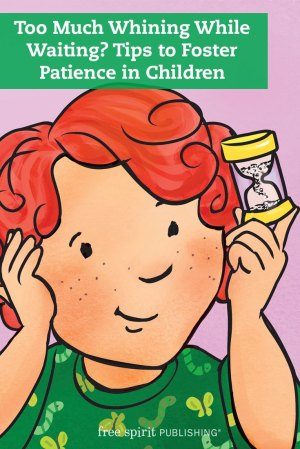 Do you know Veruca Salt? She’s the spoiled, impatient young girl from Roald Dahl’s children’s book Charlie and the Chocolate Factory, which was made into the classic Willy Wonka movie. Veruca is terribly demanding: “Hey, Mummy! . . . I’ve decided I want a squirrel. Get me one of those squirrels!” In the movie, she sings, “Don’t care how—I want it nowwwww!” If Veruca is denied, she shouts, stomps, and complains. The words delayed gratification aren’t in her vocabulary.
Do you know Veruca Salt? She’s the spoiled, impatient young girl from Roald Dahl’s children’s book Charlie and the Chocolate Factory, which was made into the classic Willy Wonka movie. Veruca is terribly demanding: “Hey, Mummy! . . . I’ve decided I want a squirrel. Get me one of those squirrels!” In the movie, she sings, “Don’t care how—I want it nowwwww!” If Veruca is denied, she shouts, stomps, and complains. The words delayed gratification aren’t in her vocabulary.
Waiting and being patient are learned skills. To avoid “Veruca moments” with your own children, teach them delayed gratification and model patience for them. Today, we’re raising kids in a world that’s faster, busier, and more technologically advanced than in the past. We’re all about instant gratification and having answers at our fingertips. Now we’ve got Google and Alexa and Siri—we don’t expect to wait.
Yet waiting is a fact of life. We stand in lines, sit in waiting rooms or in traffic, waiting, waiting, for our turn to go. Children have things to wait for too: the start or end of the school day, their favorite activities, a ride home, a meal . . . and for bigger aspirations like getting older and stronger and more independent. All this waiting—this anticipating—leads to mixed emotions: excitement, anxiety, frustration, longing, boredom, hope. While raising and teaching children, we can recognize what they may be feeling in these moments and find ways to help.
I’ve written a board book for toddlers and a more in-depth paperback for preK–3 about waiting because I think patience is a key skill in life, one that we’re always working on far into adulthood. As teachers or parents, we have to practice patience—it is practically in our job descriptions! It’s just a must. I believe that developing a sense of optimism helps, and so does using positive language with children. For example, you might teach children to use self-talk to ease the pain and brain-drain of waiting. Try the following phrases from Waiting Is Not Forever:
- “Waiting is not forever.”
- “I’m calm. I’m patient.”
- “I can chill a little longer.”
- “This will be worth the wait!”
- “I can wait a while with a smile.”
Visuals also can help children learn to wait. Try a combination of visual timers, countdown calendars, and interactive classroom calendars to share daily activities and special events. Tools like these allow children of all ages to develop routines, understand how time passes, and become a little more patient as they wait for what’s to come.
You can also include nonverbal signals when teaching patience. Consider how a child tries to get your attention when you’re talking—usually by interrupting you with questions and requests. You can agree on an unspoken signal you use to say “Wait, please,” whether it’s a raised pointer finger or a gentle arm squeeze.
When my daughter was in kindergarten, her teacher Wendy was a model of calm and patience. Wendy taught the children to get her attention by silently placing a hand on her shoulder when she was sitting at a desk or table. She’d smile, nod, and make eye contact with the waiting child, and without saying a word, Wendy had communicated that she’d soon be ready to answer a question or offer a helping hand.
I started using the same technique at home and found it especially handy when I was on the phone and my daughter had to wait until I was done. Wendy always said, “Thank you for waiting,” and I took up the same practice at home. As children learn patience, you can delay their wait a bit longer, giving a gentle squeeze or nod every few minutes to show that you haven’t forgotten the request.
We all know that waiting can be frustrating—especially when waiting itself is the only activity. It’s so boring to stand in a line, tapping your foot in annoyance and rolling your eyes at everyone. Instead, show children that you can keep your mind and hands occupied while you wait.
When possible, make waiting time interactive. This could mean playing a game like I Spy or 20 Questions, reading or drawing together, using a fidget toy to take the focus off waiting, or telling each other jokes and riddles. If waiting needs to be quiet time, bring along activity books, puzzles, and stickers. Model positive waiting behavior. Use a calm voice and a patient smile.
Avoid the trap of always using technological devices like video games, phones, or tablets as the expected distraction from waiting. Children can become reliant on screens and gadgets whenever they’re in a vehicle, waiting room, or line. (I’m not suggesting that screens are “bad” or that you should never use them. Just make sure they’re not the go-to in every “I’m bored” situation.)
Waiting is downtime, which can offer us the opportunity to talk, observe, and reflect. In other words, it’s okay to be bored—be bored together. Finding fun distractions and interactions can help pass the time.
As a writer, I try to tell myself, “Boredom is your friend.” When I’m bored, that’s a sign that I really should be using my imagination and writing words. I think of boredom as my call to action. (No shouting, stomping, or complaining, ha!) I try to use waiting time to stretch, sketch, noodle, doodle, and daydream.
In fact, I wrote the first draft of Waiting Is Not Forever during several long, rainy days at a cabin, waiting for a little sunshine. I had scratch paper, a pencil, an idea—and time on my hands. I learned that having to wait can be . . . great!
Reading is a fun way to pass the time while waiting. Try these boredom busters:
- I’m Bored by Michael Ian Black, illustrated by Debbie Ridpath Ohi
- The Boring Book by Shinsuke Yoshitake
 Elizabeth Verdick has written children’s books for kids of all ages, from toddlers to teens. She has worked on many titles in the Laugh & Learn® series. Elizabeth loves helping kids through her work as a writer and an editor. She lives in Minnesota with her husband and their two (nearly grown) children, and she plays traffic cop for their many furry, four-footed friends
Elizabeth Verdick has written children’s books for kids of all ages, from toddlers to teens. She has worked on many titles in the Laugh & Learn® series. Elizabeth loves helping kids through her work as a writer and an editor. She lives in Minnesota with her husband and their two (nearly grown) children, and she plays traffic cop for their many furry, four-footed friends
“Too Much Whining While Waiting? Tips to Foster Patience in Children” originally appeared at freespiritpublishingblog.com. Copyright © 2020 by Free Spirit Publishing. All rights reserved.

